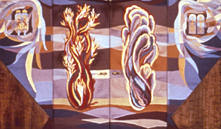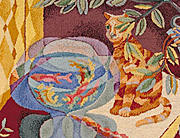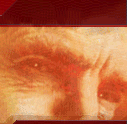Haydon's first mural was painted at
Pickering College in 1934, and it was also his first commission
for public art. It would be approximately 20 years before the
next opportunity arose, but that occasion would begin a significant
new chapter in his career. Public art brought Haydon's beliefs
in community service, the artist's responsibility to communicate,
the importance of art in everyday life, and even his own religious
convictions to focus in one arena. In fact it was in the area
of religious art that he was most eloquent.
In an article Haydon wrote in 1965 for the International Journal of Religious
Education, he summarized his views on the artist's responsibility to communicate
effectively when working on religious art commissions:
"The artist is needed who will speak through
art to each particular congregation in a manner appropriate to it, so that
art will attract and not repel, lead
and not follow, inspire and not please. His qualifications are sympathy, sensitivity,
knowledge, and trust, in addition to qualifications as an artist. His task
is to make a work of art that has lasting meaning for the people who will live
with it. It will be good or bad not according to its style or place in contemporary
art, but according to its power and quality of expression, which also will
determine its right to survive."
He continues with:
"The burden of communication must be shared between artist and congregation
with leaders of the congregation having a key role interpreting the congregation
to the artist and the artist and the work of art to the congregation...sincere
religious art will speak directly, personally, and simply - being modern without
trying to be Modern, and seeking refined rather than extravagant means of expression."

Temple Beth Am, Chicago |
In 1956 Haydon began a long and fruitful association with Percival
Goodman, a New York architect known for Jewish temple designs.
Goodman had commissioned
artists such as Robert Motherwell and Adolph Gottlieb to create art works for
his previous temples. He also made a practice of asking that the people of
the congregation contribute some work toward the enhancement of their building
and left unfinished places in the building to be filled with works of contemporary
art. Now Goodman was looking for a Chicago artist to design an ark curtain,
a Parochet,
for his newly designed structure, Temple Beth Am, located at South Shore Drive
and Coles Avenue in Chicago. The congregation was specific about wanting
a Chicago area artist because their plan was to have the curtain done by the
women of the congregation in gross point tapestry. They needed an artist to
design and select colors for the work, as well as instruct and assist the women
in its execution. Only a local artist could devote enough time and attention
to a project of this scale. On Goodman's part, he was looking for an artist
who was good with abstraction but who would also incorporate symbolic content.
In seeking out a local artist, Goodman turned to the sculptor, Milton Horn.
Milton Horn had lived and worked in New York from 1922.
In 1939 he moved to Olivet, Michigan where he was the
Carnegie Professor of Art and Artist-in-Residence
at Olivet College until 1949, when he moved to Chicago. Horn's first commission
in the Chicago area was also his first commission for a synagogue.53 It
was a relief sculpture for the exterior of the West
Suburban Temple Har Zion in
River Forest, IL. Already a well known artist, Horn produced a sculpture
for this temple where "For
the first time, so far as is known, a human form appeared
on the exterior of a synagogue.
The sculpture was noticed around
the
world."
Horn and Haydon were acquainted not only from exhibiting together in various
group shows and working together on the Ferguson Fund issue in 1955, but also
from being on an Art Institute of Chicago advisory committee in 1952 that studied
how the Art Institute could help Chicago art achieve more prominence. The committee,
selected by Daniel Catton Rich, the museum's director and who appointed Haydon
as Chairman, came to be called the Haydon Committee on Chicago Art. (Box 322C(3))
By 1956 when Goodman was seeking a local artist for the Temple Beth Am Parochet,
Horn was well known to both Goodman and Haydon, so it was a natural step for
him to propose Haydon for the Parochet project. In his letter to Goodman, dated
8/12/56, Horn recommends Haydon, lists his qualifications and mentions Haydon's
father, A. Eustace Haydon, to demonstrate that Harold would be sympathetic
to religious subjects. Horn also notes that Harold has "a
good deal of tact, so that the women would do as he wishes." Estelle
Horn, Milton's wife, was also encouraging over the project. When she sent Haydon
a copy of
Milton's letter of recommendation, she also described Goodman as "the
most publicized synagogue architect in the world," as
well he was, his reputation being established since the late 1930s.
Temple Beth Am was dedicated in June of 1957 and actual work on the Parochet
began in July of 1957, but Haydon began working on designs in the fall
of 1956. He took them through a variety of transformations before settling
on
his final
plan and producing a scale model for the congregation's approval. For the
doors, Haydon chose a Pillar of Fire and a Pillar of Cloud to represent
how the Israelites
were led through the wilderness, which he suggested in the planes of color
across the doors. The triangular side panels contain abstractions of cherubim
holding the commandment tablets on one side and torah scrolls on the other.
Symbols of the twelve tribes of Israel and the seven branches of the Menorah
are also incorporated. Its colors were chosen to "harmonize with the
stained glass windows of the Temple."
Horn's suggestions to Haydon concerning the style and symbolism were that "...the
design of the curtain must be read from everywhere in the sanctuary," so
he recommended using "...a series of large, symbolic
forms and well defined color areas." This
advice Haydon followed for both visual and practical reasons. In the construction
process, the design would have to be enlarged
to a full size cartoon and transferred onto the cloth. A line drawing with
clearly indicated color areas would be best suited for this purpose. Most notable
in his design, though, is the absence of the binocular vision style. While
still committed to this technique in his personal work, the symbolic content
and sacred purpose of the Parochet precluded any effort to promote his own
art philosophy.
The work was done in the rug hooking technique and took forty women 1,200 hours,
spread out over the course of a year, to produce the nine-foot high by twenty
two-foot wide work. They used 720 skeins of heavy wool rug yarn in 34 colors,
some of which were specially dyed. Haydon selected a very strong warp cloth,
drew the design on the reverse side, and indicated the color code and pile
depth-of-stitch numbers, making sure that the process and materials would be
easy enough to work with and would allow groups to work together. According
to his own description of the process:
"Several persons could work at the
same time on each part, pushing the needles through from the back of the
warp
cloth, and working from the center
out to
the edges. No warp frame or hooking frame was needed, and the workers could
sit around tables, seeing the pattern grow under their hands and enjoying
the company of their fellow workers."

Cat and Goldfish Bowl |
After the women completed their
work, Haydon clipped and sheared some areas to sculpt the wool,
thus increasing the textural qualities as well as modulating
color areas. To understand the intricacies and subtleties of
the rug hooking
technique and how to apply it in an art context Haydon made rugs himself,
such as the one shown here, untitled (Cat
and Goldfish Bowl), to study the
process and what variations are possible, as well as to see the
color effects. Milton Horn had
advised him:"Remember that the gross
point surface receives light entirely different from paint. Each stitch
will not only catch a highlight
on it but
will also cast a shadow."
After the success of the Beth Am Parochet, Goodman asked Haydon to do a second
project for a new temple. It was to become, in Haydon's opinion, one of his
most important artistic productions. Never being one to shy away from a challenge,
his challenge now was to create two panels, each 8' x 5 1/2', in Byzantine
glass mosaic, although he had never worked in that
medium. The project was for Temple Beth-El in Gary, IN, where Goodman wanted
mosaic panels in the vestibule
to flank the entrance to the sanctuary.61 Subject matter for the Temple Beth-El
mosaics came as a suggestion from Goodman and was developed by Haydon with
the assistance of the temple's Rabbi, Irving Miller. Goodman's idea came from
the poet Hyam Byalik's work Law and Legend or Halakah and Aggada, and he asked
Haydon if he would accept the challenge of interpreting this poet's work in
visual form.

The Legend
(partial view) |
After a number of conferences with Rabbi Miller to discuss interpretations
and iconography, and correspondence with Goodman, Haydon arrived at a final
design that combines both traditional Jewish images with references to the
new temple's modern design, and even scenes of Gary, IN. Central to the panel
of The Law,
the figure of Aaron as high priest is cloaked in robes designed from the biblical
description found in Exodus. Interspersed in the panel are symbols of the twelve
tribes of Israel and other traditional references, as well as an I-beam to
represent Goodman's new steel and glass temple, while across the lower section
are scenes of Gary's steel sheds and smoke stacks. The other panel, The
Legend, recalls both the Tree of Life and the
seven branched menorah. Behind are the Pillar of Fire and the Pillar of Cloud,
which traditionally symbolize how the Israelites were led through the wilderness,
but are also, according to Haydon, a contemporary reference to the steel works
and smoke stacks of Gary. Along the lower portion of this panel there is an
image of the steel sheds, but more dominant is a scene of Lake Michigan's shore
with the sand dunes that are a prominent part of northern Indiana's landscape.
It took Haydon about three years to make both the mosaic panels, since he was
teaching full time during that period and only spending the summers working
on their fabrication. During the first eight months he spent time interpreting
Hyam Byalik's poetry, consulting with Rabbi Miller and selecting the iconography
from biblical and secular sources. By the end of May, 1958, Haydon had produced
his final drawings, along with a scale model of the vestibule. The summers
of 1958 and 1959 were spent at the Vermont farm constructing the first panel,
The Law. This panel was exhibited at the Renaissance Society at the U of C
from Oct. 18 - Nov. 14, 1959, before being dedicated in the temple on December
4, 1959. The second panel, The Legend, was completed by the fall of 1960, exhibited
at the Chicago Public Library, and was dedicated in the temple on November
25, 1960.
The type of mosaic construction Haydon used is extremely time consuming,
but it was a process he enjoyed and described in an article published in
the magazine
Inland Architect in 1965.62 The Byzantine glass mosaic technique uses tesserae
made by breaking glass disks into pieces measuring about 3/8" wide, 5/8" long,
and 1/4" to 3/8" thick. Each individual tessera is set in a fine,
slow drying cement with only about 1/16" left between each piece. What
defines the process as being in the true Byzantine technique is that the broken
edge of the glass is exposed as the mosaic's surface. Also, according to Haydon, "for
the richest color effects the mortar or mastic should be kept down an eighth
of an inch below the surface of closely spaced tesserae. Then the light entering
the interstices returns enriched in color, while the shadow lines of the interstices
serve as powerful means of drawing or modeling form."63 The broken glass
surface gives a shimmering, irregular face that plays more dramatically in
the light, unlike the smooth, flat surfaces found in ceramic or stone mosaics.
There are also seemingly unlimited colors of glass tesserae to choose from.
According to Haydon, "there may be as many as 10,000 colors available
to the mosaicist, plus thirty or more tones and hues of gold. Many of the glass
colors are shades and tints, for the more neutral tones are essential to color
modulation and are required to enhance the brilliance of pure hues."64
By doing these panels himself, Haydon was able to take advantage of such
an extensive array of colors and create a much more complex work than would
have
been possible if volunteers had done the tesserae setting. It also allowed
him to fully explore the medium and learn its advantages, subtleties and
limitations so that he would be able to teach others in the future.
His next Byzantine glass mosaic commission came in 1962-63
from the Church of St. Cletus in LaGrange, IL.
Their newly dedicated church had a St. Francis chapel that Father Gerald
J. Morrissey wanted to decorate with a mosaic. A very large project, the
mosaic
was designed to fit on three walls for a total of 45 feet in width. Its complex
design, showing different scenes from St. Francis' life, is organized into
irregular shapes of various heights. Congregation members did the actual
mosaic work, with Haydon instructing and supervising them along the way.
To coordinate
and control the quality of the work, the church organized an "All Parish
Mosaic Workshop" to train the 112 volunteers who participated in the
project. It took them only 3 months to lay an estimated 250,000 individual
tessera pieces,
approximately 500 pounds, in over 80 colors and 8 shades of gold.
Instead of using the direct method of mosaic construction that he used when
constructing The Legend and The Law panels, Haydon trained the congregation
in the indirect method, a method that was easier for the volunteers to follow
and that allowed the design to be divided among several workers. With the indirect
method, the design is worked in reverse and the tesserae are glued face down
to paper with a boiled flour paste. To begin, Haydon transferred the design,
in reverse and in full scale, onto large rolls of heavy paper, paper which
was designed not to warp or buckle when wet. He also marked each color area.
The design was then cut into sections and individuals or groups began the process
of gluing the tesserae. After the paste dried for 2-3 days, the work was transferred
to the wall, which had been prepared with a layer of a fine grained mosaic
cement. Following the design of the work, Haydon applied each papered section
to the wall, patting gently to embed the tesserae into the wet cement. The
paper was then wetted and removed from the face of the mosaic. Individual tessera
were checked and adjusted to assure each was well set. By carefully washing
the surface with a wet sponge, the remaining paste and cement on the tesserae
surfaces was removed. Once the cement had set for several days, a diluted wash
of water and hydrochloric acid was used to remove any final cement.
Some members of the St. Cletus congregation were hesitant about beginning
such an ambitious project, not certain that enough members would volunteer.
Father
Morrissey, though, had confidence and pressed forward, and of course Haydon
knew it could be done. Haydon did elect to do the 5 faces of St. Francis
himself, but he was counting on the inexperience of the volunteers to achieve
what he
called "a genuine primitive quality in the final result." It is
that immediacy and directness that give the mosaic a powerful and contemporary
look.
At the same time, that primitive quality, together with the shimmering glass
surface, give the work an other worldly aspect.
|



